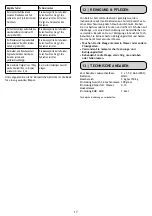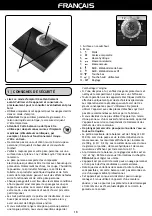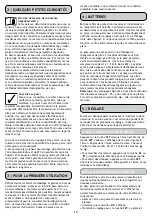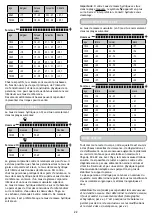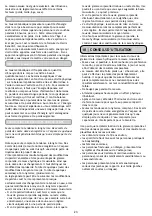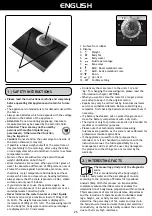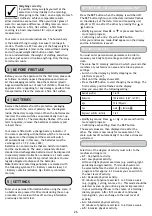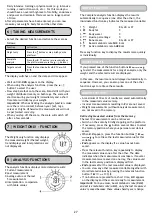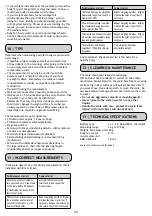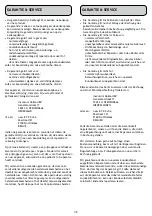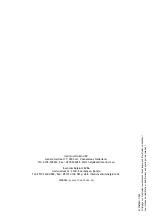
• If your weight increases over the medium term and the
body fat percentage falls or stays the same, then you
could have built up valuable muscle mass.
• If your weight and body fat percentage fall
simultaneously then your diet is working – you are
losing fat mass. Ideally you should support your diet
with physical activity, fitness or power training. By this
means, you can increase your muscle percentage over
the medium term.
• Body fat, body water or muscle percentages should
not be added (certain elements of muscle tissue also
contain body water).
Important when measuring body fat/body water/muscle
percentage:
• If possible, always weighs yourself at the same time
of day (ideally in the morning), after going to the toilet,
on an empty stomach and without clothes to achieve
comparable results.
• The measurement may only be carried out while
barefoot and it is helpful if the soles of your feet
are slightly damp. Completely dry soles can result
in unsatisfactory results, as they have insufficient
condutivity.
• Stand still during the measurement.
• Wait several hours after unusually strenuous activity.
• Wait approx. 15 minutes after getting out of bed so that
the water in your body can be distributed.
• remember that only long-term trends are important.
Short-term changes in weight within a few days are
usually caused by a loss of fluid. Body water plays an
important role towards our general wellbeing.
The measurement is not reliable for:
• Children under approx. 10 years of age;
• Professional sporters and bodybuilders;
• Pregnant women;
• Persons with fever, undergoing dialysis, with symptoms
of edema or osteoporosis;
• Persons taking cardiovascular medication.
• Persons taking vascodialating or vascoconstricting
medications;
• Persons with substantial anatomical deviations in
the legs relative to their total height (leg length
considerably shorter or longer than usual).
If the scale detects an error during measurement, this is
indicated with
Err
or
0_Ld
.
possible causes of errors
causes of error
The scale was not activated be-
fore you stood on it. If you stand
on the scale before 0.0 appears
in the display, the scale will not
function correctly.
Activate the scale correctly
(wait for 0.0) and repeat the
measurement.
The electrical resistance between
the electrodes and the soles of
your feet is too high (e.g. with
heavily callused skin).
repeat weighing barefoot. Slightly
moisten the soles of your feet if
necessary. remove the calluses on
the soles of your feet if necessary.
possible causes of errors
causes of error
The fat percentage is outside the
measurable range (less than 5% or
greater than 50%).
repeat weighing barefoot. Slightly
moisten the soles of your feet if
necessary.
The water percentage is outside
the measurable range (less than
36% or greater than 70%).
repeat weighing barefoot. Slightly
moisten the soles of your feet if
necessary.
The muscle and bone percentages
are outside the measurable range
(age and gender related).
repeat weighing barefoot. Slightly
moisten the soles of your feet if
necessary.
The maximum load-bearing
capacity of 150 kg (330 lbs) was
exceeded.
Only weigh the maximum
permissible weight.
And remember: Physical exercise is the basis for a
healthy body.
The scale should be cleaned occasionally.
Dirt and dust has a tendency to collect on the rubber
electrodes. Always stand on the scale barefoot or wearing
socks as the rubber surfaces will quickly become dirty if
you waer shoes. use a damp cloth to clean the scale. Do
not use abrasive detergents and never immerse the scale
in water.
• Do not use aggressive solvents or cleaning agents!
• never immerse the scale in water or any other
liquids.
• handle the scale with care, protect the scale from
impact with hard object and do not drop it.
Battery type
3 x 1,5 V, AAA (Lr03), microlight
measuring range
5 kg to 150 kg
Weight, bone mass unit 100 g
Body fat, water,
0.1%
muscle mass unit
Bmr, Amr unit
1 Kcal
Subject to technical modifications.
10 | tips
11 | incoRRect meAsuRements
12 | cLeAning & mAintenAnce
13 | technicAL specificAtions
30
Summary of Contents for PW 620 BM
Page 1: ...PERSONENWEEGSCHAAL PERSONENWAAGE P SE PERSONNE SCALE...
Page 2: ...2...
Page 31: ...31...
Page 34: ...34...
Page 35: ...35...


